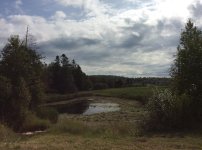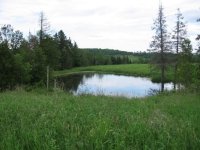The sediment basin, if designed right, should capture most of the silt coming in from the feeder brook. At least I hope it will....
search for "settling chambers" on
www.koiphen.com
more so if you have a creak / grass areas of fields that feed the lake. a DIY settling chamber (area were you can get in with a backhoe) to dig a dirt hole / trench. before the water enters the pond/lake. can help settle and remove a good amount of solids. again if designed correctly. normally with settling chambers though require a good amount of space. settling chambers work better with large "dwell time" there are 2 different main types, round / cylinder shape settling chambers, and then long wider/deeper settling chambers.
the actual stuff coming into the pond/lake, may be to small / light in weight / mass to actually settle out. at which case a settling chamber is basically useless. and may only be effective in the sudden large down pours of rain, were proper grass water ways are not able to filter out majority of the heavier / bigger stuff, due to, to much rain water to handle at one time.
==================
the sledge ya getting from the pond, a warning, you can get yourself into trouble, with various "smell laws / nuisance laws" or how ever it is worded. kinda like taking pig waste and spreading it on a field but not properly injecting it to a given depth and /or mixing it with the soil. to help reduce the stink along with make sure it does not wash away during the next couple rains.
the stuff coming out of the pond, you may try to work it like a compost pile. were maintaining proper heat inside the pile. to keep the bugs, parasites, bacteria, etc... in good healthy condition. along with mixing some soil with it. but this may mean dealing with what ever ya taking out a couple times a day turning it over. ya need to remember the sledge coming out from bottom of a lake is basically a "septic system on your home" from fish waste, to dead rotten fish that predators didn't eat, to urine from animals, to everything else.
other words treat it with some respect, along with were you place it and were winds blow, if the stink blows into your home, or a neighbors home you maybe in for some trouble!
you may find it takes a couple years for the sledge coming out of the lake to actual be use-able / be able to drive on it without sinking. along with you may find that it may not be a suitable substance to use as a deeper compaction layer soil. "to squishy / wet" and if placed in areas were "wash outs could occur" such as in ditches, hills, etc... it may end up leaving large wash outs within it. and cause erosion problems for years to come if not correctly dealt with.
other words, don't dig a hole and push all the crud into it, and then cover it up with some dry dirt. other words, find a place to put it were it can drain water out of it, but still allow water to drain without causing major washout / erosion to happen.



